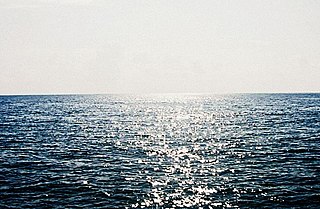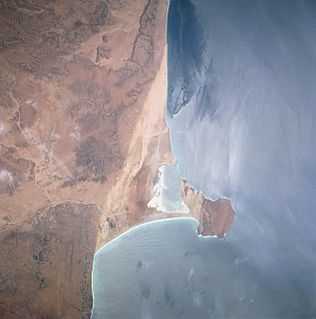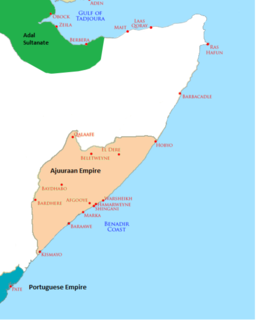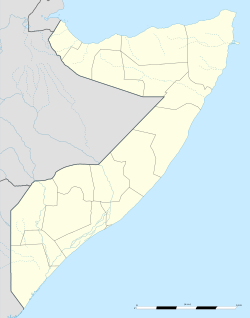
The Arabian Sea is a region of the northern Indian Ocean bounded on the north by Pakistan, Iran and the Gulf of Oman, on the west by the Gulf of Aden, Guardafui Channel and the Arabian Peninsula, on the southeast by the Laccadive Sea and the Maldives, on the southwest by Somalia, and on the east by India. Its total area is 3,862,000 km2 (1,491,000 sq mi) and its maximum depth is 4,652 meters (15,262 ft). The Gulf of Aden in the west connects the Arabian Sea to the Red Sea through the strait of Bab-el-Mandeb, and the Gulf of Oman is in the northwest, connecting it to the Persian Gulf.

Cape Guardafui is a headland in the autonomous Puntland region in Somalia. Coextensive with Puntland's Gardafuul administrative province, it forms the geographical apex of the Horn of Africa. Its shore at 51°27'52"E is the second easternmost point on mainland Africa after Ras Hafun. The offshore oceanic strait Guardafui Channel is named after it.

Lower Juba is an administrative region (gobol) in southern Somalia. With its capital at Kismayo, it lies in the autonomous Jubaland region. It has green forests and wildlife including lions, giraffes, hippos, crocodiles, and hyenas.

Kismayo is a port city in the southern Lower Juba province of Somalia. It is the commercial capital of the autonomous Jubaland region.

Ras Hafun, also known as Cape Hafun, is a promontory in the northeastern Migiurtinia region of Somalia. Jutting out into the Guardafui Channel, it constitutes the easternmost point in Africa. The area is situated near the Cape Guardafui headland. It is joined to the mainland at the town of Foar, by a sand spit 20.0 km (12.4 mi) long, 1.0–3.0 km (0.62–1.86 mi) in width, and 5.0 m (16.4 ft) above sea level. The fishing town of Hafun is located on the promontory, 2.0 km (1.2 mi) east of the sand spit.
The Bajuni Islands are an archipelago in southern Somalia. They are situated in the Somali sea in the southern coast of Jubaland, from Kismayo to Ras Kiyamboni.
Bayla, is a coastal town along the Guardafui Channel in the northeastern Bari region of Somalia. It is the capital of the Bayla District.

The Ajuran Sultanate, also referred to as Ajuuraan, and often simply Ajuran, was a Somali Empire in the Middle Ages in the Horn of Africa that dominated the trade in the northern Indian ocean. They belonged to the Somali Muslim sultanate that ruled over large parts of the Horn of Africa in the Middle Ages. Through a strong centralized administration and an aggressive military stance towards invaders, the Ajuran Empire successfully resisted an Oromo invasion from the west and a Portuguese incursion from the east during the Gaal Madow and the Ajuran-Portuguese wars. Trading routes dating from the ancient and early medieval periods of Somali maritime enterprise were strengthened or re-established, and foreign trade and commerce in the coastal provinces flourished with ships sailing to and coming from many kingdoms and empires in East Asia, South Asia, Europe, the Near East, North Africa and East Africa.

The Battle of Jilib was a battle in the 2006 Somali War fought by the Islamic Courts Union (ICU) and affiliated militias against Ethiopian and Transitional Federal Government (TFG) forces for control of the town of Jilib. It began on 31 December 2006, when ICU forces dug in and defended the town to prevent approach to Kismayo, the last stronghold of the ICU.
Kamboni is a town in the Badhaadhe district of Lower Juba region, Somalia, which lies on a peninsula near the border with Kenya. The tip of that peninsula is called Ras Kamboni. The town is located 274 kilometers south of Kismayo. The Town population is 79,000. American officials have said that it has served as a training camp for extremists with connections to Al-Qaeda; al-Sharq al-Awsat reported in May 1999 that al-Qaeda was installing sophisticated communications equipment in the camp.

The Battle of Ras Kamboni was a battle in the Somalia War (2006–2009) fought by the Islamic Courts Union (ICU) and affiliated militias against Ethiopian and the Somali Transitional Federal Government (TFG) forces for control of Ras Kamboni, a town near the Kenyan border which once served as a training camp for the militant Islamist group Al-Itihaad al-Islamiya.

A promontory is a raised mass of land that projects into a lowland or a body of water. Most promontories either are formed from a hard ridge of rock that has resisted the erosive forces that have removed the softer rock to the sides of it, or are the high ground that remains between two river valleys where they form a confluence. A headland, or head, is a type of promontory.

Ras El Bar, which translates to "head of land", is a resort city in the Governorate of Damietta, Egypt. It is located on the Mediterranean Sea at the mouth of the Damietta Nile branch. There are approximately 25,000 permanent residents in the city. However, during the summer peak holiday season, from July to September, the population quickly expands to over 250,000.

Hizbul Islam, also known as Hizbul Islaami, Hisbi Islam, or Hezb-ul Islam, was a Somali Islamist group formed after four Islamist groups merged to oppose the new Somali government of President Sheikh Sharif Ahmed. The four groups were: Hassan Aweys' the ARS-A, Jabhatul Islamiya, Hassan Abdullah Hersi al-Turki's the Mu'askar Ras Kamboni and Muaskar Anole, the Marehan clan's Militia and Harti clan's militia. These groups previously took part in the fighting against the Ethiopian occupation of Somalia.
Muaskar Anole also known as Anoole, Caanole, Mu'askar Anole, Mucaskarka Caanoole, Caanoole Mu'askar, Mucaskarka al-Furqan, al-Furqan Camp or al-Furqan Forces was an Islamist militia in Somalia. The group participated in the 2006-2009 insurgency against Ethiopia and in January 2009 merged with the Asmara based wing of the Alliance for the Re-liberation of Somalia, led by Sheikh Hassan Dahir Aweys, the Ras Kamboni Brigade, led by Sheikh Hassan Abdullah Hersi al-Turki and Jabhatul Islamiya to form Hizbul Islam which became the second most powerful insurgent group in Somalia which continued fighting the TFG and AMISOM peacekeepers, after Ethiopian withdrawal. Little is known about the group.

The Ras Kamboni Brigades also known as the Ras Kamboni Brigade, Muaskar Ras Kamboni or Mu'askar Ras Kamboni was an Islamist insurgent group active in Somalia, which took part in the anti-Ethiopian insurgency and later in the insurgency against the new Transitional Federal Government of Sheikh Sharif Ahmed. It was founded by Hassan Abdullah Hersi al-Turki, who was a commander of the Islamic Courts Union and the commander of its predecessor Itihaad al Islamiyah. In January 2009, after the Ethiopian withdrawal they merged with the Asmara-based wing of the Alliance for the Re-liberation of Somalia, led by Sheikh Hassan Dahir Aweys, Jabhatul Islamiya, led by Sheikh Mohamed Ibrahim Hayle and Muaskar Anole to form Hizbul Islam and continue the war against the TFG. During the 2009 Battle of Mogadishu, where in Hizbul Islam took part, Hassan Turki led a group of fighters from the Ras Kamboni Brigade from Kisimayo to Mogadishu as reinforcements, to join the battle.
The Baraawe raid, code named Operation Celestial Balance, was a helicopter assault by United States Special Operations Forces against the al-Qaeda-linked terrorist Saleh Ali Saleh Nabhan and associated al-Shabaab militants near the town of Baraawe in southern Somalia.
Balla Balla River is a river in the Pilbara region of Western Australia.

The Raskamboni Movement was a jihadist Islamic movement led by Sheikh Ahmed Madobe, the current president of the Jubaland state in southern Somalia. After fighting with Al-Shabaab they managed to capture Kismayo with the help of Kenya.

The Guardafui Channel is an oceanic strait off the tip of the Horn of Africa that lies between the Puntland region of Somalia and Socotra to the west of the Arabian Sea. It connects the Gulf of Aden to the north with the Indian Ocean to the south. Its namesake is Cape Guardafui, the very tip of the Horn of Africa. Notable places of interest include the Alula Lagoon.













